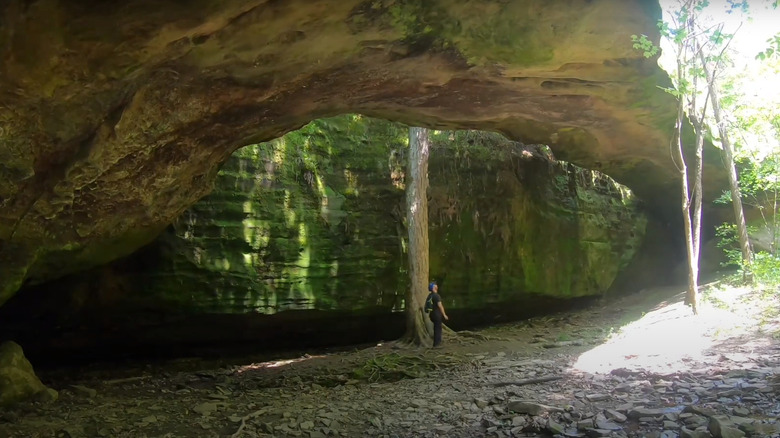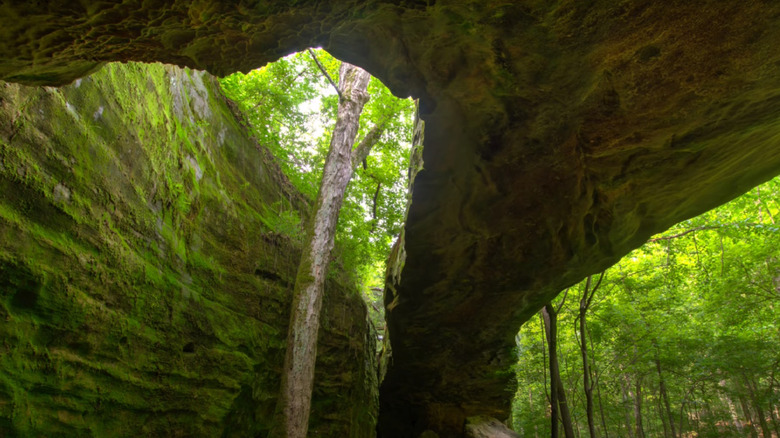Inspecting History with Julian Gower/YouTube
There’s an unexpected thrill to be experienced when you come across some of nature’s most impressive works of art in the form of natural stone arches. The National Park Service highlights places like Arches National Park in Utah as hosting more than 2,000 of these towering wonders. The Natural Arch and Bridge Society would readily point you toward additional fantastic formations waiting to be found in abundance in Arizona. However, if you’re heading to Eastern America, you might be surprised to find the state of Kentucky is home to an impressive arch of its very own.
Mantle Rock in Smithland has earned the title of the largest stone arch of its kind sitting East of the Mississippi River. Standing 30 feet high and spanning 188 feet wide, this sandstone arch is a beautiful and unique landmark in Kentucky that enjoys a place within the protected Mantle Rock Preserve. The very best way to access Mantle Rock and to learn more about the area’s history along the way is via the hiking trail leading directly to the arch. Once you’ve laced up your boots and are ready to hit the trail, you’ll find this to be a historic hike with big visual rewards included in the journey.
Hike to an impressive arch surrounded by great scenery

Brook and Holler/YouTube
The Mantle Rock Trail is a loop that covers around 2.6 miles of terrain through the Mantle Rock Preserve. It’s an easy route leading right to the arch making it a great option for avid hikers and those looking for a leisurely stroll too. You’ll only be gaining 246 feet of elevation, making it simple to focus on your scenic surroundings as you trek through.
Exploring the Mantle Rock Trail is an opportunity to enjoy views of bluffs and honeycomb rock formations along the way. There are also a variety of shelters where you can spend some time photographing the landscape or savoring a picnic with family and friends. Geology enthusiasts will be thrilled to find fluorite deposits along this route while the nearby stream provides the essence for a rich ecosystem. There’s an array of wildflowers that bloom here in the spring and towering trees thriving year-round.
Once you reach the arch, you’ll want to spend time admiring the landmark from varying angles including underneath the sandstone for an impressive vantage point. Take a moment to look for the June grass that grows around this arch too because it’s the only place in Kentucky where this species of plant is known to grow. Hairy lipfern, pinweed, little bluestem, and prickly pear cactus are also found in this area and if you’re into wildlife-watching, a trip to Mantle Rock can include spotting songbirds, squirrels, wild turkeys, and deer.
A landmark linked to the Trail of Tears

Inspecting History with Julian Gower/YouTube
Today, the Mantle Rock Trail and its arch are inviting landmarks for outdoor adventures looking to enjoy and explore something scenic and new. However, in the past, the area has marked travel of a much different and historical nature. Mantle Rock sits on the Trail of Tears National Historic Trail which was followed by the Cherokee people after their forced removal from their tribal lands. The Indian Removal Act of 1830 forced the Cherokee to leave their homes behind and make their way on foot to modern-day Oklahoma. In total, more than 60,000 Native Americans were displaced as a result of the Indian Removal Act affecting more than 18 tribes.
The winter of 1838 was particularly harsh and saw around 1,766 Cherokee tribe members sheltering on the trail around Mantle Rock. They waited for the ice covering the Ohio River to melt before being able to continue toward their final destination. Mantle Rock sits at nearly the halfway point of the journey the Cherokee were forced to take. It’s estimated that around 10,000 Cherokee passed by Mantle Rock on their 800-mile journey that many didn’t live to complete. Today, Mantle Rock is still honored among the Cherokee who frequently return to pay their respects to the area as a place that provided refuge to their ancestors during a devastating and dark period in history.

